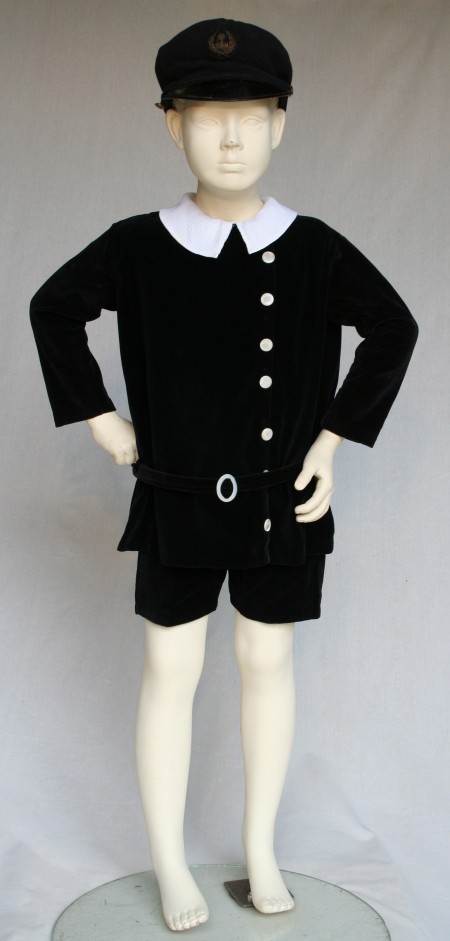
Country Vintage Clothing: Australia

Figure 1.--Here we see what looks like a tunic suit done in velvet or velveteen. It is not dated, but we woukd guess was worn i the 1910s, perhaps the early-20s. Our Australian archive is still rather limited so we are notv sure to what extent boys wore garments like this in Australia. Note the white collar and buttons set to the side. We wiykd guess this is for a pre-school boy. This looks different than the tunic we have seen in America or even Europe. the tunic is very short, in many ways more like a jacket than a tunic. Unfortunately as the garment is all black, it is difficult to make out details. Source: Griffith Pioneer Park Museum,
|
|
Vintage clothing is a valuable source of information that is often not available from the photographic record, especially the 19th and early-20th century photographs. Vintage clothing provide information about color not available from black and white photographs. Vintage clothing also provides information on fabriuc that often can not be determined from photographs. There are also sometiumes labels with useful information. We do not yet have many vintage Australian items.
This garment is identified as a pelisse worn by a boy named James Somerville (1880s). We have no information on James. Thec garment is in the collection of the Cavalcade of History and Fashion. We are not entirely sure why this garment is described as a pelisse. The pelisse is a garment that is not well defined. We see quite a range of definitions. We note a range of definitions for a pelisse, such as 'a long cloak or coat made of fur or lined or trimmed with fur'. We note fur is often associted wiyh a pelisse. This would makec sence as the pelise is often described as an outer garmen, either a coat or cloak. Another definitiion is a 'a woman's loose lightweight cloak with wide collar and fur trimming'. And another definitio Manhy but not all definitions stress that it is a womnan's garment. One source describes pelisse as, 'any of a vaiety of long outer garments'. Tge garment here does not appear to us to be either long or a outergarment.' Of course smaller versions, duch as this one here could be worn by girls and younger boys in the 19th century. The Museum tells us that, 'James Somerville’s pelisse of broidery anglaise from the early 1880s ... is an example of a male child’s dress which buttons up at the front.'
This garment does not look like a cloak or coat, but more like a dress to us.
This rust-colored vintage dress has a lace collar and shoulder trim as well as velvet trim. The Powerhouse Museum in Sydney believes it is a boy dress. It is shown worn with lacy pantalettes. Pantallettes or drawers were worn in the 19th century, but often the ones boys wore were often plainer. We are not sure that the two are conncted or just shown togethger. Note that the yellowing (ageing) of the white lace is not seen in the panatalettes. We are not sure how the museum reached this conclusion as there is no provinance provided. The dress seems rather short. We do not notice such short dressed in the photographic record, at least in Britain and America. We do notice lacy pantelettes like this, but on dresses with shorter hems. Perhaps styles were different in Australia, but more likely Australians at the time just followed English styles. The Museum is not sure about the date, suggesting the late-19th to early-20th century. We think that the late-19th century is more likely, especially if the pantalettes are associated with the dress. Nor or we sure about the size of thge dress and the agevof the child which woukld have worn this. These vintage garments are useful additions to the HBC archive in part because they provide color infornmation.
Velvet Tunic Suit (1910s)
Here we see what looks like a boy's tunic suit done in velvet or velveteen (fugure 1). It is not dated, but we would guess was worn in the 1910s, perhaps the early-20s. Our Australian archive is still rather limited so we are not sure to what extent boys wore garments like this in Australia. Note the white Eton collar and buttons set to the side. Also notice the belt. They were widelky worn with tunics. The outfit has straight-leg knee pants. They were worn with American and Europen tunic suits, but bloomer knickers were more cimmoWe would guess this was for a pre-school boy. This looks different than the tunic we have seen in America or even Europe. the tunic is very short, in many ways more like a jacket than a tunic. Unfortunately as thecgatment is all black, it is difficult to make out details. The cap looks ratherstrange for an Austrralian boy. We have not noted thgese caps in the pohotographic record.
HBC

Navigate the Boys' Historical Clothing Web Site:
[Return to ther Main vintage clothing page]
[Return to ther Main Australian page]
[Introduction]
[Activities]
[Biographies]
[Chronology]
[Clothing styles]
[Countries]
[Topics]
[Bibliographies]
[Contributions]
[FAQs]
[Glossaries]
[Images]
[Links]
[Registration]
[Tools]
[Boys' Clothing Home]
Created: 3:04 AM 2/28/2012
Last updated: 4:10 AM 1/28/2014



